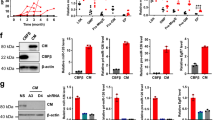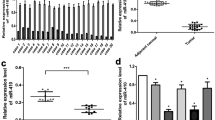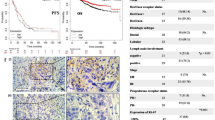Abstract
Aberrant activation of c-kit proto-oncogene contributes to abnormal cell proliferation by altering the tyrosine kinase signaling and constitutes a crucial impetus for leukemogenesis. Epigenetic silencing of tumor-suppressive microRNAs (miRNAs) is a key oncogenic mechanism for the activation of oncogenes in tumors. In this study, several miRNAs potentially binding to the 3′-untranslated region of human c-kit mRNA were screened by luciferase reporter assays. Among these miRNAs, miR-193a was embedded in a CpG island and epigenetically repressed by promoter hypermethylation in acute myeloid leukemia (AML) cell lines and primary AML blasts, but not in normal bone marrow cells. Importantly, miR-193a levels were inversely correlated with c-kit levels measured in 9 leukemia cell lines and 27 primary AML samples. Restoring miR-193a expression in AML cells harboring c-kit mutation and/or overexpression, either by synthetic miR-193a transfection or by DNA hypomethylating agent 5-azacytidine (5-aza) treatment, resulted in a significant reduction in c-kit expression at both RNA and protein levels and inhibition of cell growth. The growth-inhibitory activity of miR-193a was associated with apoptosis and granulocytic differentiation. Moreover, 5-aza-induced c-kit reduction could be partially blocked by miR-193a inhibitor, leading to a reversal of antiproliferative and proapoptotic effects of 5-aza. These data reveal a critical role for methylation-repressed miR-193a in myeloid leukemogenesis and the therapeutic promise of upregulating miR-193a expression for c-kit-positive AML.
This is a preview of subscription content, access via your institution
Access options
Subscribe to this journal
Receive 50 print issues and online access
$259.00 per year
only $5.18 per issue
Buy this article
- Purchase on Springer Link
- Instant access to full article PDF
Prices may be subject to local taxes which are calculated during checkout








Similar content being viewed by others
References
Ambros V . (2004). The functions of animal microRNAs. Nature 431: 350–355.
Agrawal S, Unterberg M, Koschmieder S, zur Stadt U, Brunnberg U, Verbeek W et al. (2007). DNA methylation of tumor suppressor genes in clinical remission predicts the relapse risk in acute myeloid leukemia. Cancer Res 67: 1370–1377.
Agirre X, Vilas-Zornoza A, Jiménez-Velasco A, Martin-Subero JI, Cordeu L, Gárate L et al. (2009). Epigenetic silencing of the tumor suppressor microRNA Hsa-miR-124a regulates CDK6 expression and confers a poor prognosis in acute lymphoblastic leukemia. Cancer Res 69: 4443–4453.
Bartel DP . (2004). MicroRNAs: genomics, biogenesis, mechanism, and function. Cell 116: 281–297.
Bennett JM, Catovsky D, Daniel MT, Flandrin G, Galton DA, Gralnick HR et al. (1985). Proposed revised criteria for the classification of acute myeloid leukemia. A report of the French-American-British Cooperative Group. Ann Intern Med 103: 620–625.
Berg T, Guo Y, Abdelkarim M, Fliegauf M, Lübbert M . (2007). Reversal of p15/INK4b hypermethylation in AML1/ETO-positive and -negative myeloid leukemia cell lines. Leuk Res 31: 497–506.
Blume-Jensen P, Hunter T . (2001). Oncogenic kinase signalling. Nature 411: 355–365.
Boissel N, Leroy H, Brethon B, Philippe N, de Botton S, Auvrignon A et al. (2006). Incidence and prognostic impact of c-kit, FLT3, and Ras gene mutations in core binding factor acute myeloid leukemia (CBF-AML). Leukemia 20: 965–970.
Bueno MJ, Pérez de Castro I, Gómez de Cedrón M, Santos J, Calin GA, Cigudosa JC et al. (2008). Genetic and epigenetic silencing of microRNA-203 enhances ABL1 and BCR-ABL1 oncogene expression. Cancer Cell 13: 496–506.
Beghini A, Ripamonti CB, Cairoli R, Cazzaniga G, Colapietro P, Elice F et al. (2004). KIT activating mutations: incidence in adult and pediatric acute myeloid leukemia, and identification of an internal tandem duplication. Haematologica 89: 920–925.
Cairoli R, Beghini A, Grillo G, Nadali G, Elice F, Ripamonti CB et al. (2006). Prognostic impact of c-kit mutations in core binding factor leukemias: an Italian retrospective study. Blood 107: 3463–3468.
Cui J, Fu H, Feng J, Zhu J, Tie Y, Xing R et al. (2007). The construction of miRNA expression library for human. Prog Biochem Biophys 34: 389–394.
Datta J, Kutay H, Nasser MW, Nuovo GJ, Wang B, Majumder S et al. (2008). Methylation mediated silencing of MicroRNA-1 gene and its role in hepatocellular carcinogenesis. Cancer Res 68: 5049–5058.
Esquela-Kerscher A, Slack FJ . (2006). Oncomirs-microRNAs with a role in cancer. Nat Rev Cancer 6: 259–269.
Flotho C, Claus R, Batz C, Schneider M, Sandrock I, Ihde S et al. (2009). The DNA methyltransferase inhibitors azacitidine, decitabine and zebularine exert differential effects on cancer gene expression in acute myeloid leukemia cells. Leukemia 23: 1019–1028.
Felli N, Fontana L, Pelosi E, Botta R, Bonci D, Facchiano F et al. (2005). MicroRNAs 221 and 222 inhibit normal erythropoiesis and erythroleukemic cell growth via kit receptor down-modulation. Proc Natl Acad Sci USA 102: 18081–18086.
Fabbri M, Garzon R, Andreeff M, Kantarjian HM, Garcia-Manero G, Calin GA . (2008). MicroRNAs and noncoding RNAs in hematological malignancies: molecular, clinical and therapeutic implications. Leukemia 22: 1095–1105.
Grimson A, Farh KK, Johnston WK, Garrett-Engele P, Lim LP, Bartel DP . (2007). MicroRNA targeting specificity in mammals: determinants beyond seed pairing. Mol Cell 27: 91–105.
Garzon R, Heaphy CE, Havelange V, Fabbri M, Volinia S, Tsao T et al. (2009). MicroRNA 29b functions in acute myeloid leukemia. Blood 114: 5331–5341.
Garzon R, Liu S, Fabbri M, Liu Z, Heaphy CE, Callegari E et al. (2009). MicroRNA-29b induces global DNA hypomethylation and tumor suppressor gene reexpression in acute myeloid leukemia by targeting directly DNMT3A and 3B and indirectly DNMT1. Blood 113: 6411–6418.
Heidel F, Cortes J, Rücker FG, Aulitzky W, Letvak L, Kindler T et al. (2007). Results of a multicenter phase II trial for older patients with c-Kit-positive acute myeloid leukemia (AML) and high-risk myelodysplastic syndrome (HR-MDS) using low-dose Ara-C and Imatinib. Cancer 109: 907–914.
Jacquel A, Colosetti P, Grosso S, Belhacene N, Puissant A, Marchetti S et al. (2007). Apoptosis and erythroid differentiation triggered by Bcr-Abl inhibitors in CML cell lines are fully distinguishable processes that exhibit different sensitivity to caspase inhibition. Oncogene 26: 2445–2458.
Jiao B, Wu CF, Liang Y, Chen HM, Xiong SM, Chen B et al. (2009). AML1-ETO9a is correlated with C-KIT overexpression/mutations and indicates poor disease outcome in t(8;21) acute myeloid leukemia-M2. Leukemia 23: 1598–1604.
Kindler T, Breitenbuecher F, Marx A, Beck J, Hess G, Weinkauf B et al. (2004). Efficacy and safety of imatinib in adult patients with c-kit-positive acute myeloid leukemia. Blood 103: 3644–3654.
Kozaki KI, Imoto I, Mogi S, Omura K, Inazawa1 J . (2008). Exploration of tumor-suppressive microRNAs silenced by DNA hypermethylation in oral cancer. Cancer Res 68: 2094–2105.
Lewis BP, Burge CB, Bartel DP . (2005). Conserved seed pairing, often flanked by adenosines, indicates that thousands of human genes are microRNA targets. Cell 120: 15–20.
Lujambio A, Calin GA, Villanueva A, Ropero S, Sánchez-Céspedes M, Blanco D et al. (2008). A microRNA DNA methylation signature for human cancer metastasis. Proc Natl Acad Sci USA 105: 13556–13561.
Li LC, Dahiya R . (2002). MethPrimer: designing primers for methylation PCRs. Bioinformatics 18: 1427–1431.
Liu Q, Fu H, Sun F, Zhang H, Tie Y, Zhu J et al. (2008). miR-16 family induces cell cycle arrest by regulating multiple cell cycle genes. Nucleic Acids Res 36: 5391–5404.
Lennartsson J, Jelacic T, Linnekin D, Shivakrupa R . (2005). Normal and oncogenic forms of the receptor tyrosine kinase kit. Stem Cells 23: 16–43.
Lee KH, Lotterman C, Karikari C, Omura N, Feldmann G, Habbe N et al. (2009). Epigenetic silencing of MicroRNA miR-107 regulates cyclin-dependent kinase 6 expression in pancreatic cancer. Pancreatology 9: 293–301.
Larizza L, Magnani I, Beghini A . (2005). The Kasumi-1 cell line: a t(8;21)-kit mutant model for acute myeloid leukemia. Leuk Lymphoma 46: 247–255.
Livak KJ, Schmittgen TD . (2001). Analysis of relative gene expression data using real-time quantitative PCR and the 2(-Delta Delta C(T)) Method. Methods 25: 402–408.
Liu S, Wu LC, Pang J, Santhanam R, Schwind S, Wu YZ et al. (2010). Sp1/NFkappaB/HDAC/miR-29b regulatory network in KIT-driven myeloid leukemia. Cancer Cell 17: 333–347.
Marcucci G, Radmacher MD, Maharry K, Mrózek K, Ruppert AS, Paschka P et al. (2008). MicroRNA expression in cytogenetically normal acute myeloid leukemia. N Engl J Med 358: 1919–1928.
Osada H, Takahashi T . (2007). MicroRNAs in biological processes and carcinogenesis. Carcinogenesis 28: 2–12.
Paschka P, Marcucci G, Ruppert AS, Mrózek K, Chen H, Kittles RA et al. (2006). Adverse prognostic significance of KIT mutations in adult acute myeloid leukemia with inv(16) and t(8;21): a Cancer and Leukemia Group B Study. J Clin Oncol 24: 3904–3911.
Reilly JT . (2003). Receptor tyrosine kinases in normal and malignant haematopoiesis. Blood Rev 17: 241–248.
Roman-Gomez J, Agirre X, Jiménez-Velasco A, Arqueros V, Vilas-Zornoza A, Rodriguez-Otero P et al. (2009). Epigenetic regulation of microRNAs in acute lymphoblastic leukemia. J Clin Oncol 27: 1316–1322.
Renneville A, Roumier C, Biggio V, Nibourel O, Boissel N, Fenaux P et al. (2008). Cooperating gene mutations in acute myeloid leukemia: a review of the literature. Leukemia 22: 915–931.
Saito Y, Liang G, Egger G, Friedman JM, Chuang JC, Coetzee GA et al. (2006). Specific activation of microRNA-127 with downregulation of the proto-oncogene BCL6 by chromatin-modifying drugs in human cancer cells. Cancer Cell 9: 435–443.
Schnittger S, Kohl TM, Haferlach T, Kern W, Hiddemann W, Spiekermann K et al. (2006). KIT-D816 mutations in AML1-ETO-positive AML are associated with impaired event-free and overall survival. Blood 107: 1791–1799.
Tenen DG . (2003). Disruption of differentiation in human cancer: AML shows the way. Nat Rev Cancer 3: 89–101.
Wang YY, Zhou GB, Yin T, Chen B, Shi JY, Liang WX et al. (2005). AML1-ETO and C-KIT mutation/overexpression in t(8;21) leukemia: implication in stepwise leukemogenesis and response to Gleevec. Proc Natl Acad Sci USA 102: 1104–1109.
Youssef EM, Chen XQ, Higuchi E, Kondo Y, Garcia-Manero G, Lotan R et al. (2004). Hypermethylation and silencing of the putative tumor suppressor Tazarotene-induced gene 1 in human cancers. Cancer Res 64: 2411–2417.
Acknowledgements
We thank Y Ding, Y-Y Xu, N Wang, C-W Xu, M Li, M-X Chen and W-D Han for excellent technical assistance. We also thank Professor X-F Zheng and H-J Fu from Beijing Institute of Radiation Medicine, China, for presenting the modified pGL3-control plasmid and miRNA expression plasmids. This work was supported by the National Natural Science Foundation of China (nos 81000221, 90919044 and 30971297) and the National 973 Project of China (no. 2005CB522400).
Author information
Authors and Affiliations
Corresponding author
Ethics declarations
Competing interests
The authors declare no conflict of interest.
Additional information
Supplementary Information accompanies the paper on the Oncogene website
Supplementary information
Rights and permissions
About this article
Cite this article
Gao, XN., Lin, J., Li, YH. et al. MicroRNA-193a represses c-kit expression and functions as a methylation-silenced tumor suppressor in acute myeloid leukemia. Oncogene 30, 3416–3428 (2011). https://doi.org/10.1038/onc.2011.62
Received:
Revised:
Accepted:
Published:
Issue Date:
DOI: https://doi.org/10.1038/onc.2011.62
Keywords
This article is cited by
-
Low expression of miR-182 caused by DNA hypermethylation accelerates acute lymphocyte leukemia development by targeting PBX3 and BCL2: miR-182 promoter methylation is a predictive marker for hypomethylation agents + BCL2 inhibitor venetoclax
Clinical Epigenetics (2024)
-
A novel therapeutic strategy: the significance of exosomal miRNAs in acute myeloid leukemia
Medical Oncology (2024)
-
Epigenetic regulation in hematopoiesis and its implications in the targeted therapy of hematologic malignancies
Signal Transduction and Targeted Therapy (2023)
-
LncRNA MAFG-AS1-induced acute myeloid leukemia development via modulating miR-147b/HOXA9
Environmental Science and Pollution Research (2022)
-
Non coding RNAs as the critical factors in chemo resistance of bladder tumor cells
Diagnostic Pathology (2020)



